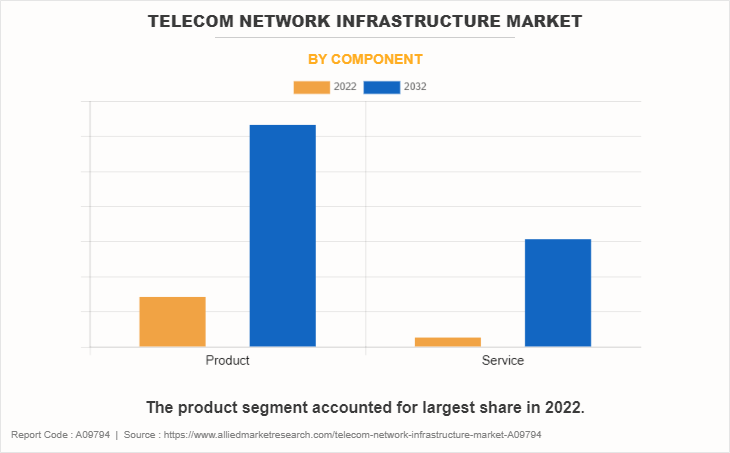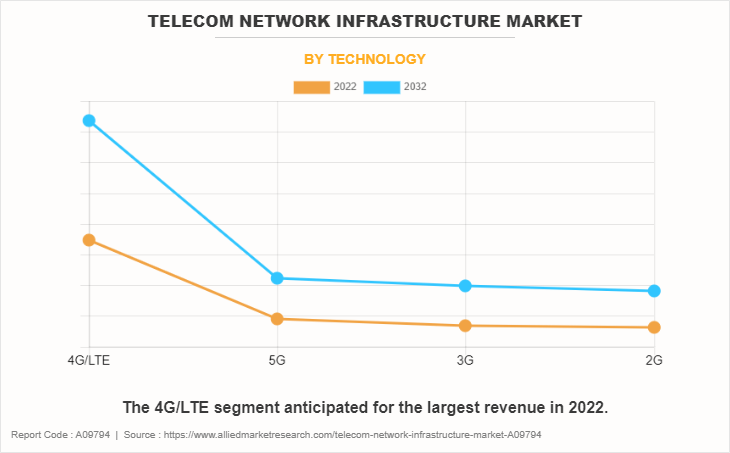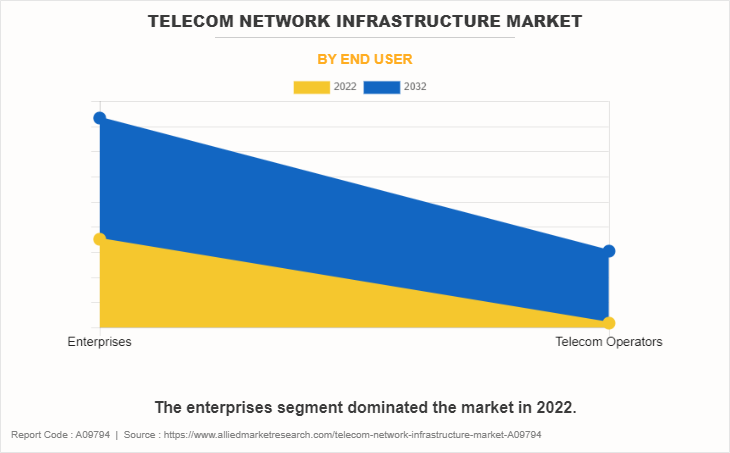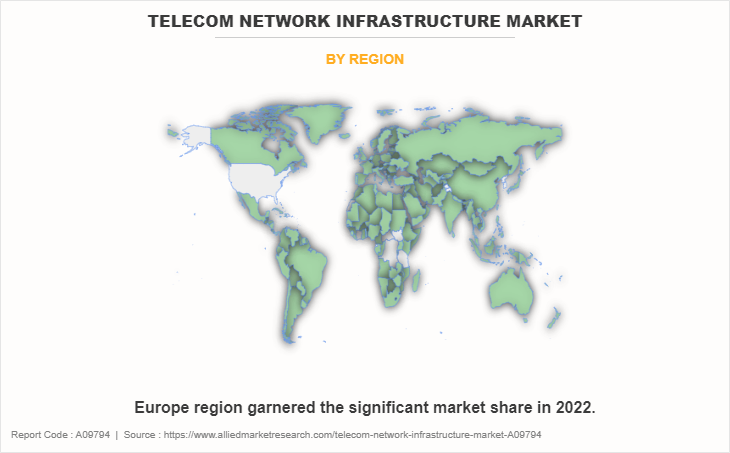Telecom Network Infrastructure Market Research, 2032
The global telecom network infrastructure market was valued at $96.9 billion in 2022 and is projected to reach $173.8 billion by 2032, growing at a CAGR of 6.3% from 2023 to 2032. The telecom network infrastructure is the framework that enables the transmission of data and voice traffic, in addition to the introduction of new technologies that will provide new market opportunities, such as network virtualization, cloud services, and heterogeneous network integration. In this fiercely competitive and dynamic industry, telecom providers are working hard to deliver high-quality services at affordable rates.

The global telecommunications market has been undergoing a constant transformation with the adoption and integration of cutting-edge communication technologies such as 5G, IoT, and NB-IoT Through a wired or wireless channel, telecommunication is an infrastructure that enables the movement of various forms of data, including speech, text, audio, and video, at any time and anywhere in the globe. The field of telecommunications has developed into a vibrant industry that has a big impact on global social and economic progress. The telecommunications industry is expanding its services and coverage throughout the world and solidifying its place in the daily lives of people. Providers of phone, telecommunications, and internet services are included in the telecom sector.
At the outset of the COVID-19 pandemic, the market experienced an upturn due to an increase in demand for telecom network infrastructure. Post-pandemic, the industry quickly adjusted as the demand for telecom network infrastructure grew alongside an increase in the sale of products. This shift led to innovation and a subsequent rebound in the market.
Over the past few decades, the sector has grown from voice calls on telephones to mobile data calls, internet conversations, text messages, and TV broadcasting services. Smartphone use is growing along with population growth and social modernization. In addition, substantial technological advancements in the telecom sector caused the defense sector to depend more on telecommunications services and products for improved and expanded communication. An increase in consumer happiness has led operators to update their price plans and services with a focus on increased demand for 5G telecom infrastructure and 5G telecom networks with higher capacity.
Segmentation Overview
The telecom network infrastructure market is segmented into components, Technology, and End users.
By component, the market is classified into products and services. The product segment generated the largest revenue in 2022.

By technology, the market is bifurcated into 2G, 3G, 4G/LTE, and 5G. The 4G/LTE segment dominated the market in 2022.

By end user, the market is divided into telecom operators and enterprises. The enterprises segment accounted for the largest share in 2022.

Region-wise, the market is analyzed across North America, Europe, Asia-Pacific, and LAMEA, along with their prominent countries.
Country-wise, the U.S. acquired a prime share in the telecom network infrastructure market in the North American region, and it is expected to grow at a significant CAGR during the forecast period of 2023-2032.
In Europe, the UK dominated the telecom network infrastructure market demand in terms of revenue in 2022 and is expected to follow the same trend during the forecast period. However, the UK is expected to emerge as the fastest-growing country in Europe's surrounding market with a CAGR of 6.86%.
In the Asia-Pacific region, China is expected to emerge as a significant market for the telecom network infrastructure industry, owing to a significant rise in investment by prime players due to an increase in the growth of consumer electronics in rural and urban regions.
In the LAMEA region, the Middle East garnered a significant market share in 2022. The LAMEA market has witnessed an improvement, owing to the growth in the inclination of prime vendors towards utilizing the telecom network infrastructure across this region. Moreover, the Middle East region is expected to grow at a high CAGR of 5.58% from 2023 to 2032.

Competitive Analysis
Competitive analysis and profiles of the major global telecom network infrastructure market players that have been provided in the report include Qualcomm Incorporated, Samsung Electronics Co., Ltd., Cisco Systems, Inc., Nokia Corporation, Huawei Technologies Co., Ltd., CommScope Holding Company, Inc., Juniper Networks Inc., Fujitsu, ZTE Corporation, and Sprint Corporation. These key players adopt several strategies such as new product launch & development, acquisition, partnership & collaboration, and business expansion to increase the telecom network infrastructure market share during the forecast period.
Top Impacting Factors
The telecom network infrastructure market growth is expected to witness notable growth owing to rising demand for network maintenance and adoption of 5G network infrastructure. Moreover, the emergence of the Internet of Things (IoT) is expected to provide lucrative telecom network infrastructure market opportunities during the forecast period. On the contrary, government network radiation rules limit the growth of the telecom network infrastructure industry.
Historical Data & Information
The global telecom network infrastructure industry is highly competitive, owing to the strong presence of existing vendors. Vendors of the telecom network infrastructure with extensive technical and financial resources are expected to gain a competitive advantage over their competitors because they can cater to market demands. The competitive environment in this market is expected to worsen as technological innovations, product extensions, and different strategies adopted by key vendors increase.
Key Developments/ Strategies
Qualcomm Incorporated, Samsung Electronics Co. Ltd., Cisco Systems, Inc., Nokia Corporation, and Huawei Technologies Co., Ltd. are the top companies holding a prime share in the market. Top market players have adopted various strategies, such as product launches, to expand their foothold in the telecom network infrastructure.
- In May 2023, Cisco announced its manufacturing in India, which was a major step in the expansion of its footprint in the country. This move was a part of Cisco's strategy to create an even more diverse and resilient global supply chain and support India’s vision of becoming a global manufacturing hub. With this investment, Cisco caters to the growing demand from customers in India and aims to drive more than $1 billion in combined domestic production and exports in the coming years.
- In February 2023, Cisco and NTT Ltd., a leading IT infrastructure and services company, announced a collaboration to drive private 5G adoption across the automotive, logistics, healthcare, retail, and public sectors. NTT and Cisco planned to co-innovate and jointly bring to market the technology and managed services that enable enterprise customers to deploy Private 5G successfully and achieve better business outcomes.
- In March 2023, Huawei launched the Eco series antennas that reduce site power consumption, improve network energy efficiency, and save OPEX. These ultra-energy-efficient antennas reduce carbon emissions while benefiting the environment and society. Eco series antennas help operators build green, high-performance 5G networks without needing more energy, even during surges in network traffic.
Key Benefits for Stakeholders
- This study comprises an analytical depiction of the telecom network infrastructure market size along with the current trends and future estimations to depict the imminent investment pockets.
- The overall telecom network infrastructure market analysis is determined to understand the profitable trends to gain a stronger foothold.
- The report presents information related to key drivers, restraints, and opportunities with a detailed impact analysis.
- The current telecom network infrastructure market forecast is quantitatively analyzed from 2022 to 2032 to benchmark the financial competency.
- Porter's five forces analysis illustrates the potency of the buyers and suppliers in the telecom network infrastructure.
- The report includes the market share of key vendors and telecom network infrastructure market trends.
Telecom Network Infrastructure Market Report Highlights
| Aspects | Details |
| Market Size By 2032 | USD 173.8 billion |
| Growth Rate | CAGR of 6.3% |
| Forecast period | 2022 - 2032 |
| Report Pages | 321 |
| By Component |
|
| By Technology |
|
| By End User |
|
| By Region |
|
| Key Market Players | ZTE Corporation, Cisco System, Inc., Fujitsu, Nokia Corporation, Juniper Networks Inc., Huawei Technologies Co., Ltd., Sprint Corporation, CommScope Holding Company, Inc., Qualcomm Incorporated., Samsung Electronics Co Ltd. |
Analyst Review
The telecom network infrastructure market is expected to leverage high potential for the button batteries and thin film batteries during the forecast period. Owing to 5G networks and availability of smartphones as well as e-commerce. Japan, India, and China are key countries in growth of the market. India and China were the leading global Internet users with around 854 billion clients as stated by the International Telecommunication Union. Increase in government initiatives by incorporating semiconductors are expected to help in expansion of the Asia-Pacific market. The introduction of the International Finance Corporation in North America and European countries is also expected to help the market grow. Asia-Pacific is expected to dominate this market, owing to rapidly growing population, rise in internet penetration, and adoption of smartphones.
Companies are focusing on leveraging new technologies to offer advanced 5G network solutions to cater to evolving end-user requirements. Key players have adopted various growth strategies to enhance and develop their product portfolio, garner maximum market share, and increase their market penetration. Furthermore, constant need has been witnessed for technological advancements in communication networks to adjust with the increasing mobile data traffic management demand, owing to which adoption of telecommunication services is expected to increase in the upcoming years.
Key telecom network infrastructure market leaders profiled in the report include Qualcomm Incorporated, Samsung Electronics Co Ltd., Cisco System, Inc., Nokia Corporation, Huawei Technologies Co., Ltd., CommScope Holding Company, Inc., Juniper Networks Inc., Fujitsu, ZTE Corporation, and Sprint Corporation.
Europe is the largest regional market for Telecom Network Infrastructure.
The upcoming trends of telecom network infrastructure market includes rising demand for network maintenance and adoption of 5G network infrastructure.
The 4G/LTE technology dominated the market in 2022.
The telecom network infrastructure market was valued at $ 96.9 Billion in 2022.
Qualcomm Incorporated, Samsung Electronics Co Ltd., Cisco System, Inc., Nokia Corporation, and Huawei Technologies Co., Ltd. are the top companies to hold the market share in Telecom Network Infrastructure.
Loading Table Of Content...
Loading Research Methodology...



